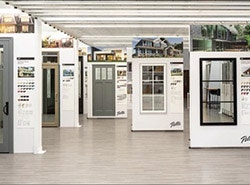Parts of a Window
Knowing the right names for parts of your window can help you avoid confusion. Read through these important window parts terms and definitions for Pella windows and you’ll be set.
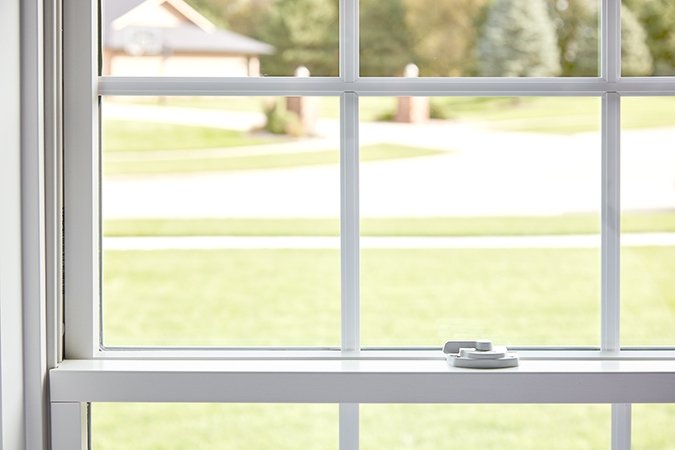
New or replacement windows can help update the exterior of your home, not to mention improve the overall energy efficiency. When selecting a window, there are many important factors to consider, including the style of your home and your geographic location as well as the window type and material that suits you. So where do you begin? The window industry has its own language for things. Window manufacturers, window installers and contractors may all speak about windows using a variety of terms. Read how we define window parts and components so you’ll be prepared to discuss your window project with anyone.

Exterior Parts of a Double-Hung Window
Double-hung windows are one of the most popular types of windows among homeowners. Available in wood, fiberglass and vinyl, double-hung windows provide a timeless look and excellent ventilation. Comprised of two vertically sliding sashes, homeowners can completely open the top sash or the bottom sash, or even open both sashes part way for enhanced airflow.
- Frame
A window frame is the framework that surrounds and supports the entire window system. It is comprised of the head, jamb and sill. - Head
The head is the main horizontal part forming the top of the window frame. - Jambs
Jambs are the main vertical parts forming the sides of a window frame. - Sill
A sill is the main horizontal part forming the bottom of the frame of a window. - Jambliner
A jambliner is a strip which goes on the sides of a window frame that provides a snug fit for the window sash.
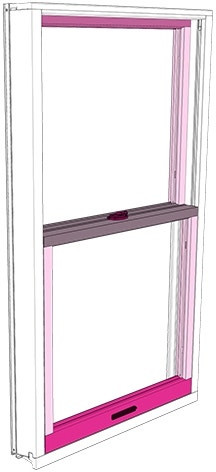
Interior Parts of a Double-Hung Window
The interior of a window is the side homeowners will see most frequently. In addition to functioning properly, you want your window to be aesthetically pleasing as well. Decorative elements, like grilles and glass, and hardware, like sash locks and lifts, can enhance the visual appeal of a double-hung window. And, depending on the material of your window, there are different finishes and color options that may be more in line with the style of your home.
- Balance (Not shown)
The balance is a mechanical device (normally spring loaded) that is used in single- and double-hung windows as a means of counterbalancing the weight of the sash during opening and closing. - Sash
The sash is the moveable part of a window made up of the vertical and horizontal frame that holds the glass. - Check Rail
On a double-hung window, the check rail is the part where the bottom part of the upper sash and the upper part of the lower sash come in contact. Also known as the middle of the window. - Glass
This refers to the framed sheet of glass within a window frame. - Rail
A rail is the horizontal piece of a window sash – comprised of the lower rail, the check rail and the upper rail. - Lower Rail
The lower rail is the lower part of the lower sash. - Upper Rail
The upper rail is the top part of the upper sash. - Lift
Most commonly found on wood windows, a lift is a handle used for raising the lower sash in a single- or double-hung window. - Sash Lock
The sash lock is a locking mechanism used on a single- or double-hung window that engages with the lock strike to reduce rattling.
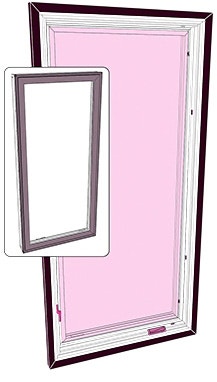
Interior and Exterior Parts of a Casement Window
A casement window is another extremely popular window type among homeowners, available in wood, fiberglass and vinyl. Operated by a hand crank, a casement windowpane extends open away from the home to catch breezes. The crank allows homeowners to direct how much air enters the home. For maximum ventilation, casement windows can open fully.
- Aluminum Clad
Aluminum clad refers to the exterior wood parts of a window that are covered with extruded aluminum, with a factory-applied finish to deter the elements. - Argon (not shown)
Argon is an inert, nontoxic gas used in insulating glass units to reduce heat transfer and make your home more comfortable year-round. - Casing
Casing is the decorative molding or framing around a window that is used to cover the space between the window frame or jamb and the wall. - Hinged Glass Panel
The glass panel on Lifestyle Series windows that opens inward to allow access to our snap-in between-the-glass blinds, shades and grilles. - Lock Handle
The lock handle is a locking mechanism located on the jamb of a window. - Operator
The operator is the crank-operated device for opening and closing casement or awning windows. - Weatherstrip (not shown)
Weatherstripping is a strip of resilient material used for covering the joint between the window sash and frame in order to reduce air leaks and prevent water from entering the structure.
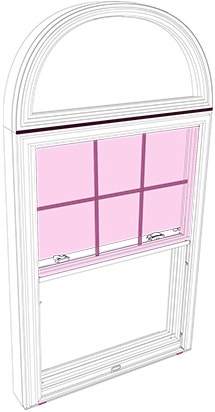
Hardware and Interior Parts of a Double-Hung Window with Circlehead
Depending on the type of window you choose and the style of your home, you may consider window combinations, including pairing a standard, operable window with fixed or picture windows — or even custom window options. Transom windows that are set above your operable window can be a beautiful way to let additional light into your home.
- Fixed Panel
A fixed panel refers to an inoperable panel of a window, like the top sash of a single-hung window or the pane of glass used in a picture window. - Mullion
The mullion is a major structural piece running either vertical or horizontal that combines two or more windows together. - Grilles
Grilles are decorative pieces that visually divide window panels, giving the glass the appearance of multiple glass panes. Grilles on Pella windows can be permanently affixed to your window through simulated divided light or between-the-glass options, or as removable roomside grilles.
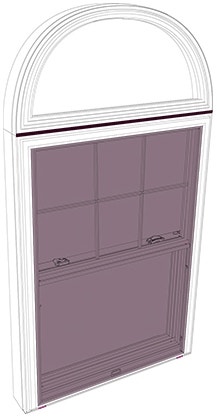
Exterior Parts of a Double-Hung Window with Circlehead
In addition to the exterior finish or cladding on your window, there are additional exterior window parts that are important to homeowners. Screens and weep holes both improve the function of a window.
- Screen
Typically woven mesh of metal, plastic, or fiberglass, screens cover a window opening so that air and light may pass through, but not insects. - Weep Hole
Weep holes help protect your home and window. These individual openings provided in the windowsill allow water or condensation to escape and help keep your window functioning properly.
Window Materials
- Wood
Wood windows include a frame and a sash that are made of solid wood. - Fiberglass
Fiberglass windows include a frame and sash made from a patented five-layer fiberglass material. - Vinyl
In vinyl windows, interior and exterior frame and sash surfaces are extruded rigid PVC.
With a better understanding of window parts and functionality, you will be prepared to discuss your window needs.
